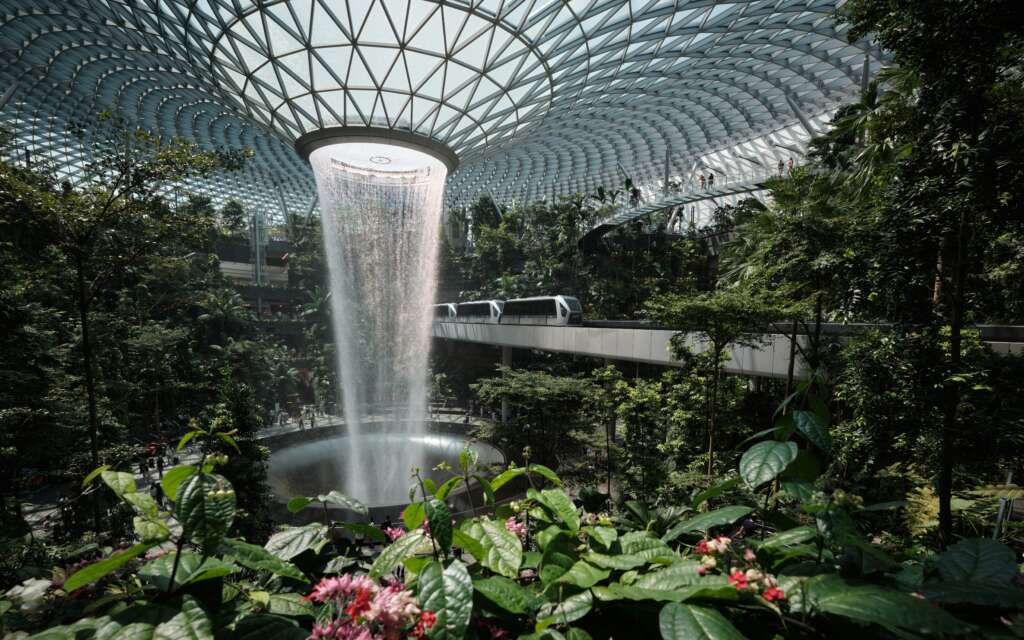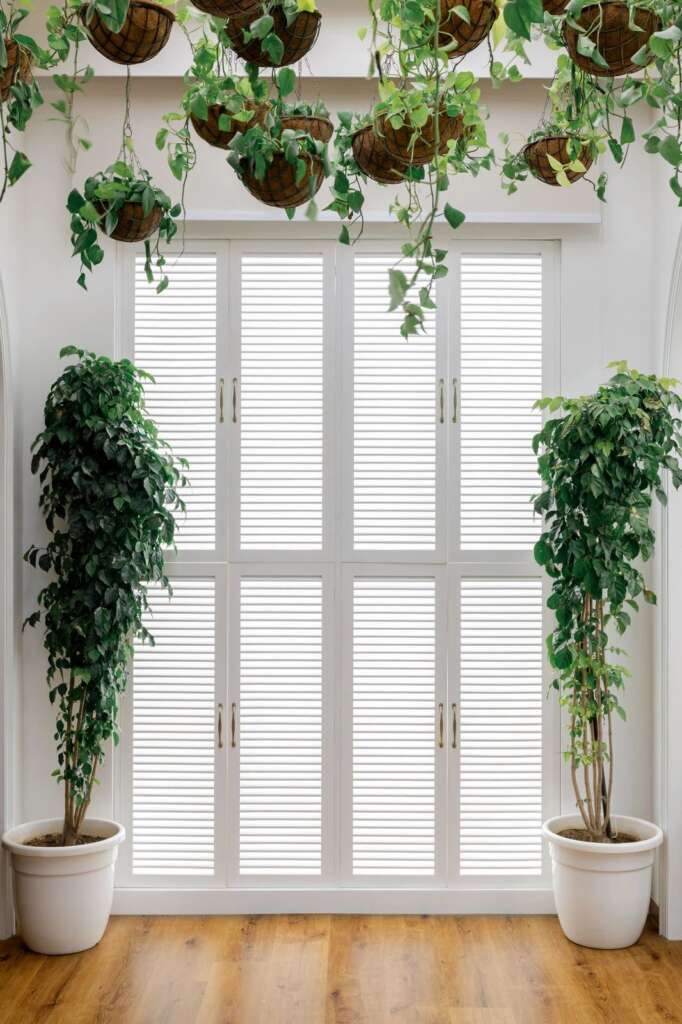Share This Article
Have you ever noticed how your mood suddenly uplifts as soon as you are in a well-lit room or a space with a water body? If yes, then you must have noticed how your lungs shred as soon as you step into a dark, abandoned room.
Well, this shift is not a coincidence. It is your body responding to its surrounding environment. And it is exactly what biophilic design is about – designing spaces that don’t just look good, but feel alive.
In this blog, we will explore what biophilic design is (beyond the buzzword), explore its benefits, and how it can be brought into the spaces we use every day.
What Is Biophilic Design?
The word biophilic comes from the Greek word “biophilia’, It can be broken down into ‘bio’(life) and ‘philia’(love), meaning love for living things. Biophilic design is a design approach that connects people with nature through built environments. It uses natural elements like water, light, air, plants, and organic materials to improve how spaces feel and function.

In today’s world, people spend nearly 90% of their time indoors, often disconnected from nature. In such scenarios, biophilic design can help in reducing stress and improving focus. A psychological study, “The Relative Benefits of Green Versus Lean Office Space: Three Field Experiments”, shows that people exposed to nature are 15% more productive than employees in a lean landscape.
Core Principles of Biophilic Design
- Visual connection to nature: The sight of a garden, trees, a body of water, or even an open sky can decrease stress.
- Material and tactile connection: Natural materials such as wood, stone, or bamboo can also be used to make a space more warm and friendly, fostering a deeper connection with nature.
- Natural light and airflow: Biophilic design usually focuses on cross ventilation, window location, and dynamically controlled lighting rather than static lighting. Today, products like Sunroof are helping architects and homeowners make the most of natural light through smart sun studies and solar mapping.

- Presence of water: Elements like fountains, ponds, or small water bodies have calming psychological effects. Even the sight and sound of water can boost productivity than the static environments.
- Spatial variety: Humans feel safest and most alert in environments where they can see without being seen. Spaces like window seats, alcoves, or tree-shaded patios offer shelter while maintaining a view. The vernacular architecture of Indian havelis and stepwells nails this balance with shaded edges and courtyards that invite pause and protection.
- Biomorphic forms and natural patterns: Organic forms like curved corners, leaf-like motifs, and branching structure can reduce mental fatigue and promote a sense of harmony.
Benefits of Biophilic Design
- Reduced Stress and Anxiety
Exposure to vegetation, sunlight, and fresh air decreases cortisol and enhances relaxation. A Terrapin Bright Green study revealed that employees who could see nature had 23 percent less stress than those who could not. - Improved Productivity and Focus
In offices, biophilic elements improve cognitive performance. Natural light alone can improve productivity by up to 15%. Mental fatigue can also be reduced by plants and visual breaks. - Faster Healing in Healthcare
Outdoor gardens, daylight, and natural materials at the hospital help in shorter recovery times and reduced medication. For instance, at Singapore’s Khoo Teck Puat Hospital, the healing gardens aren’t just for show; they’ve been linked to noticeably lower stress levels in patients. - Better Learning Outcomes in Schools
Classrooms that welcome sunlight and open directly to outdoor spaces often see more engaged students and stronger academic results. It’s why some schools in Denmark and Japan now dedicate entire zones to outdoor learning.

- Enhanced Well-Being and Satisfaction
Biophilic elements in residential and hospitality areas result in an increased level of occupant satisfaction. Human beings feel relaxed, sleep better, and report improved mood when natural elements surround them.
Also Read – Cities Confront Global Challenges: Innovative Solutions and Strategies
Application in Everyday Spaces
You do not need a huge budget or a rainforest next door to put biophilic principles into practice. Even minor, deliberate decisions can change the atmosphere of a room. Here is how you can apply it in various settings:
- Homes
In homes, biophilic design aims at instilling a relaxed and balanced mood with the elements of nature. Seating can be placed by windows to get more daylight. Add texture with the help of materials such as wood, cane, terracotta, or linen, which smooths the space. A few indoor plants, climbing greens, or vertical gardens can make even a small balcony or a corner more attractive. In traditional Indian houses, courtyards and jaali screens were not only used to achieve ventilation but also to fill the center of the house with light and life. These aspects still provide ageless guidance on the comfort of nature.
- Offices
Biophilic workplaces are more productive and effective. Good air circulation, natural light, and diversity of natural materials can greatly alleviate employee fatigue and stress. Keeping the workstations near the windows, painting the walls using peaceful hues, or installing planters throughout the office would make it more hospitable. Spaces like Godrej One in Mumbai have successfully integrated rooftop gardens and landscaped terraces to create moments of pause and recharge throughout the workday.

- Schools
Educational environments greatly benefit from natural design strategies. Students are more attentive and emotionally regulated in flexible learning spaces that offer a visual connection to the outdoors. The feeling of confinement is lessened by classrooms with large openings to daylight, cross ventilation, and natural materials such as exposed brick or wood flooring. The Riverside School in Ahmedabad has transformed the way learning spaces can be established by utilizing open-air classrooms and tree-shaded courtyards to promote exploration and play.
- Healthcare Spaces
In the wellness sector, biophilic design plays a vital role in supporting recovery and comfort. Studies have revealed that patients who have access to natural light and views of the outside world experience shorter hospital stays and reduced stress levels. Having patient rooms that overlook gardens, interior design that is earth-toned, and water features can radically transform the experience of patients, their family, and even the staff. Medanta – The Medicity in Gurugram is a strong example, using light-filled corridors, landscape buffers, and warm materials to ease the clinical feel of the environment.
- Public Spaces
Biophilic ideas are now influencing the way cities grow and function. Streets are being designed to encourage people to meet, pause, and enjoy the outdoors, while also supporting local ecology. Tree canopies provide shade, benches are tucked under greenery, and bio-swales work quietly alongside native plants to handle rainwater. In Panaji, the Campal Promenade has turned a once-underused coastal edge into a lively public space. Walking trails, indigenous landscaping, and open plazas now blur the line between the sea and the street.
Putting it All Together
Biophilic design is about creating spaces that help us to improve our health and make us feel closer to nature. It can be achieved through direct contact, such as sunlight and plants, or by indirect elements like natural textures, patterns, and artwork.
It’s a research-backed approach that improves how we feel, think, and function. From hospitals and schools to homes and offices, spaces that use biophilic design are proven to reduce stress, improve focus, and increase comfort.
And the best part? You don’t have to redesign everything to get started. Even simple changes, like adding indoor plants, using natural materials, or including nature-inspired visuals, can make a noticeable difference.
